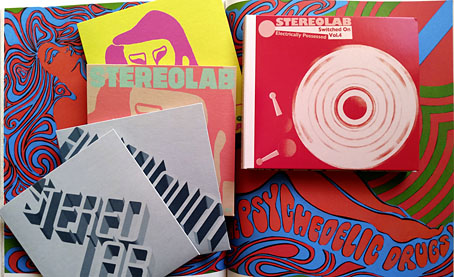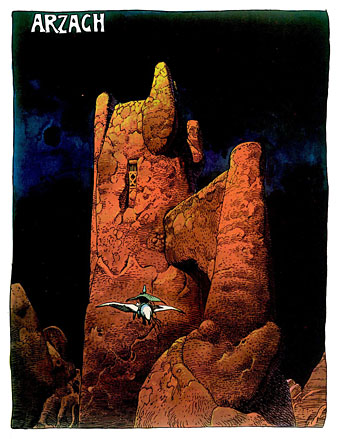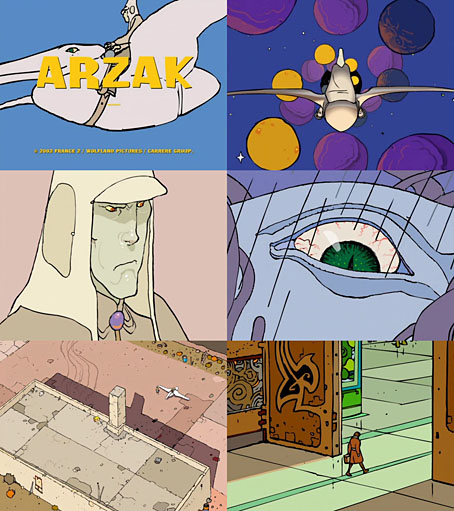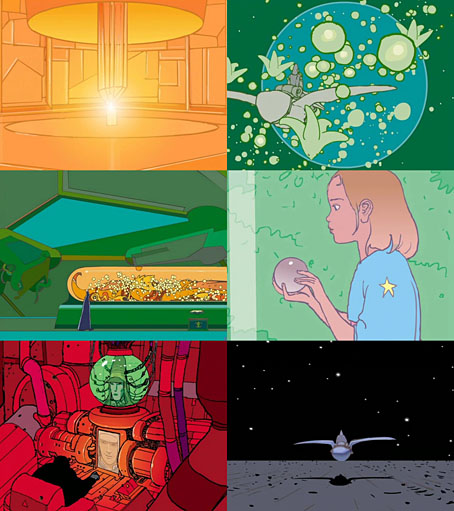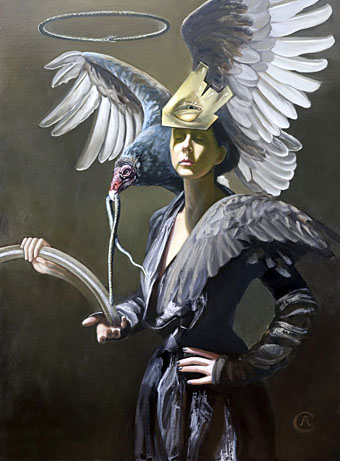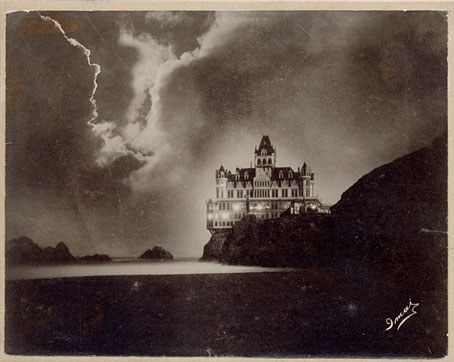This week I’m electrically possessed by Stereolab, thanks to the arrival of the fourth volume in the Groop’s Switched On series of compilation albums. As with the earlier releases, the new album collects deleted EPs, singles and other scarcities. I already had a third of this one on the First Of The Microbe Hunters EP but it’s good to finally have on disc B.U.A. (aka Burnt Umber Assembly), a previously unreleased piece from the Amorphous Body Study Centre recordings, together with more of the tour singles such as The Underground Is Coming and Free Witch And No-Bra Queen. The latter may well allude in its title and cover art to Pravda, La Survireuse, Guy Peellaert’s freedom-loving biker-hippie whose persona was modelled on Françoise Hardy. (Stereolab’s borrowings are often overt but I’ll give them the benefit of the doubt on this one.) Pravda or not, the animation that Peellaert produced with Gallien Guibert would have made a great video for the song if it was a little longer. Guibert has an updated version of the film here.
Category: {animation}
Animated films
Arzak Rhapsody
The first appearance of Arzach in Métal Hurlant, 1975.
Arzak (or Arzach, or Harzak, or Harzakc, etc) is one of the oldest of the comic characters created by Moebius, and an enduringly popular one even though the amount of pages devoted to the character is small. Moebius returned to Arzak sporadically after the first strips appeared in Métal Hurlant in 1975, where the first panel of the first story establishes the principal ingredients: the stern and resourceful explorer navigating an alien world on the back of a large white bird. Arzak’s flying companion is often described as a pterodactyl but it’s really a Moebius bird whose ancestors or cousins may be seen elsewhere in the Moebius-verse, notably the character of Deepo from The Incal.
Arzak Rhapsody is a late entry in the Arzak mythos, a series of 4-minute animated films made for French TV in 2002, all of which were written by Moebius. The animation is crude when compared to René Laloux’s Moebius-designed Time Masters (1982), but the Moebius aesthetic is present throughout, from the desert landscapes of his early strips to the glowing crystals of his later work. The stories recycle moments from the comics, most of which concern Arzak evading one of the many lethal hazards presented by the flora and fauna of the place named in the animations as “Desert B”. All 14 episodes may be viewed here with the superfluous narration translated into English. Now when do we get to see Time Masters on blu-ray?
Previously on { feuilleton }
• The Captive, a film by René Laloux
• The horror
• Chute Libre science fiction
• Heavy Metal, October 1979: The Lovecraft Special
Weekend links 547
Anti-Vanitas (2018) by Carrie Ann Baade.
• RIP Richard Corben, an artist whose work I wasn’t always keen on but whose enthusiasm for pulp weirdness and cosmic horror was matched by a pulp vitality of his own. Corben’s Den was the first story in the first issue of Heavy Metal, a strip in which Den’s ever-present penis provided some rare equality of nudity in American comics. Corben was also a lifelong Lovecraftian; his 1972 adaptation of The Rats in the Walls is one of the earliest Lovecraft-derived comic strips.
• “Wit was the great man’s defence. Once, crossing Leicester Square with a friend, he looked up and saw a cinema marquee advertising a new film: Michael Redgrave and Dirk Bogarde in The Sea Shall Not Have Them. Coward turned to his friend and said: ‘I don’t see why not. Everyone else has.'” Philip Hoare on Noël Coward’s private lives: the photographs that could have landed him in jail.
• The end of the year brings the lists: Strange Flowers’ Secret Satan, 2020 is a guide to a surfeit of delectable volumes, while at 3 Quarks Daily Dave Maier selects his favourite ambient music of the year.
It’s not an easy life, but for Layne it is better than the alternative. “There is a generation of writers who think that it is a perfectly acceptable thing to accumulate a couple of hundred thousand dollars in student loan debt and go write “takes”—contrary opinion on things like ‘Why Dogs Are Actually The Worst Pet.’” None of it is new, he says, “it’s what people were doing when Rome burned.” But it has left us worse off, he says.
“I feel like we are post-language now,” he says. “Things are more symbolic. The relationship between words and facts and objectivity and their impact seems to have separated to the point where most of the writing that I see, especially on something like Twitter, is by people baffled that people don’t get what they are trying to say. It’s depressing.”
Dominic Rushe on how Ken Layne created an alternative to clickbait in the desert
• “Underworlds, otherworlds, so many passageways on this earth to elsewheres, especially during these weeks of the year.” Nina MacLaughlin on The Shadows below the Shadows.
• Dennis Cooper‘s favourite fiction, poetry, non-fiction, film, art, and internet of 2020. Thanks again for the link here!
• The week in strange worlds: The Strange World of Colossive Press, and The Strange World of Robbie Basho.
• The Images Wish To Speak: An interview with artist Carrie Ann Baade.
• Jackson Arn on why so many filmmakers have paid homage to Pieter Bruegel.
• Physicists nail down the “Magic Number” that shapes the Universe.
• Shadow (1990) by Nusrat Fateh Ali Khan | Shadows (1994) by Pram | Shadow Of A Twisted Hand Across My House (2001) by I.E.M.
Weekend links 545

Colour wheel from The Natural System of Colours (1766) by Moses Harris.
• The Vatican’s favourite homosexual, Michelangelo di Lodovico Buonarroti Simoni, receives the ludicrously expensive art-book treatment in a huge $22,000 study of the Sistine Chapel frescos. Thanks, but I’ll stick with Taschen’s XXL Tom of Finland collection which cost considerably less and contains larger penises. Related: How Taschen became the world’s most famous erotic publishers.
• “In a metaphorical sense, a book cover is also a frame around the text and a bridge between text and world.” Peter Mendelsund and David J. Alworth on what a book cover can do.
• The Night Porter: Nazi porn or daring arthouse eroticism? Ryan Gilbey talks to director Liliana Cavani about a film that’s still more read about (and condemned) than seen.
What is important about reading [Walter] Benjamin’s texts written under the influence of drugs is how you can then read back into all his work much of this same “drug” mind-set; in his university student days, wrangling with Kant’s philosophy at great length, he famously stated, according to Scholem, that “a philosophy that does not include the possibility of soothsaying from coffee grounds and cannot explicate it cannot be a true philosophy.” That was in 1913, and Scholem adds that such an approach must be “recognized as possible from the connection of things.” Scholem recalled seeing on Benjamin’s desk a few years later a copy of Baudelaire’s Les paradis artificiels, and that long before Benjamin took any drugs, he spoke of “the expansion of human experience in hallucinations,” by no means to be confused with “illusions.” Kant, Benjamin said, “motivated an inferior experience.”
Michael Taussig on getting high with Benjamin and Burroughs
• “Utah monolith: Internet sleuths got there, but its origins are still a mystery.” The solution to the mystery—if there is one—will be inferior to the mystery itself.
• After Beardsley (1981), a short animated film about Aubrey Beardsley by Chris James, is now available on YouTube in its complete form.
• Mix of the week: The Ivy-Strangled Path Vol. XXIII – An Ivy-Strangled Midwinter by David Colohan.
• Charlie Huenemann on the Monas Hieroglyphica, Feynman diagrams, and the Voynich Manuscript.
• Katy Kelleher on verdigris: the colour of oxidation, statues, and impermanence.
• A trailer for Athanor: The Alchemical Furnace, a documentary about Jan Svankmajer.
• All doom and boom: what’s the heaviest music ever made?
• At Strange Flowers: Ludwig the Second first and last.
• At Dennis Cooper’s: Krzysztof Kieslowski Day.
• Ralph Steadman’s cultural highlights.
• RIP Daria Nicolodi.
• Michael Angelo (1967) by The 23rd Turnoff | Nightporter (1980) by Japan | Verdigris (2020) by Roger Eno and Brian Eno
Weekend links 543
Adolph Sutro’s Cliff House in a Storm (c. 1900) by Tsunekichi Imai.
• Good to see a profile of Wendy Carlos, and to hear that she’s still working even though all her albums (to which she owns the rights) have been unavailable for the past two decades. I’d be wary of praising Switched-On Bach too much to avoid giving new listeners a wrong impression. The album was a breakthrough in 1968 but was quickly improved upon by The Well-Tempered Synthesizer (1969) and Switched-On Bach II (1973). And my two favourites, A Clockwork Orange – The Complete Original Score (1972) and the double-disc ambient album, Sonic Seasonings (1972), are superior to both.
• “[Sandy Pearlman] told me that one of the main inspirations was HP Lovecraft. I said, ‘Oh, which of his books?’ He said, ‘You know, the Cthulhu Mythos stories or At The Mountains Of Madness, any of those.'” Albert Bouchard, formerly of Blue Öyster Cult, talks to Edwin Pouncey about BÖC’s occult-themed concept album, Imaginos (1988), and his affiliated opus, Re Imaginos.
• More electronica: Jo Hutton talks to Caroline Catz, director of the “experimental documentary” Delia Derbyshire: The Myths and Legendary Tapes.
• At the V&A blog Clive Hicks-Jenkins talks to Rebecca Law about his award-winning illustrations for Hansel and Gretel: A Nightmare in Eight Scenes.
• New music: Archaeopteryx is a new album by Monolake; What’s Goin’ On is a further preview of the forthcoming Cabaret Voltaire album, Shadow Of Fear.
• Celebrating A Voyage to Arcturus: details of two online events to mark the centenary year of David Lindsay’s novel.
• “Streaming platforms aren’t helping musicians – and things are only getting worse,” says Evet Jean.
• At Spoon & Tamago: the cyberpunk, Showa retro aesthetic of anime Akudama Drive.
• At A Year In The Country: a deep dive into the world of Bagpuss.
• Sinister Sounds of the Solar System by NASA on SoundCloud.
• At Dennis Cooper’s: Shirley Clarke Day.
• Mary Lattimore‘s favourite albums.
• Solaris, Part I: Bach (1972) by Edward Artemiev | Bach Is Dead (1978) by The Residents | Switch On Bach (1981) by Moderne

